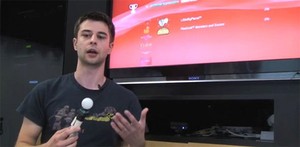
Mikhailov revealed that Dance Central probably uses a tracking technique similar to that of their PlayStation 2 EyeToy title, AntiGrav. The R&D man also explained to Eurogamer why Sony passed on the camera technology in 2002.
At some point you have to do a cost analysis and say, OK, this technology costs this much, its able to do this much, and you understand roughly what you get out of it and how much it costs you, he said. So when we were working with the 3D cameras we felt the cost of the camera outweighed the advantages of what it offered. The London Studio guys were familiar with EyeToy. With EyeToy, one of the toughest things is body-tracking. Its hard to segment the player from the background. You have lighting condition variations. Thats why a lot of EyeToy games use motion-tracking instead of parts-tracking.
EyeToy: AntiGrav [released in 2005] was an interesting exception because it uses head-tracking along with hands-tracking. Thats actually done by Harmonix, surprisingly enough, which did Dance Central.
At first they were very excited and said it was great. But when you make the games what they found was while it was more robust it didnt fundamentally enable new kinds of games. The games themselves still played like EyeToy games. EyeToy: Kinetic was an awesome exercise game. The issue with EyeToy: Kinetic is sometimes in certain lighting conditions it just wouldnt work. The people that had Kinetic work had a great time with it, but when it didnt it was a downer.
With Kinect what they found Or the PrimeSense cameras and 3DV cameras is, you can solve those lighting issues, but you still dont get a different experience. And its very hard to apply to other sorts of genres.
Talking about Dance Central, Mikhailov noted that Harmonix's experience developing EyeToy: AntiGrav for the PlayStation 2 is part of the reason the game reviewed so well. Mikhailov explained that some objects are infrared reflective, showing up as bright-white on the camera and giving them an "infinite depth". Mikhailov believes that Harmonix utilised the same silhouette data technique as in EyeToy: AntiGrav, and that's part of the reason Dance Central works so well.
Those are the funky materials that sometimes just make the tracking bad, he said. I dont know if that can be solved, but some cameras have fewer issues with them and some have more. Ill be honest with you, most of the time [those issues are] covered up by the game itself. Dance Central is a good example.
In Dance Central, if you see your silhouette missing parts you know something is going wrong. But Dance Central is clever, and the reason is, I think, because all theyre doing is silhouette-matching. I dont think theyre actually doing any skeleton-tracking. Skeleton-tracking is the hard thing. Thats the neat thing about Kinect, but its actually the hardest part. The reason they did silhouette-tracking is because the Harmonix guys worked with EyeToy and they know the best tech is the most reliable tech. So they take the z data from the camera and they just chop it out of depth and feed that into their game.
Some of the more sophisticated Kinect games, like Adventures, try to do skeleton-tracking, and thats when you get things wigging out. Thats when youre trying to do something hard. The reason Dance Central is one of the higher-rated games is because it works pretty well. Background subtraction is one thing the EyeToy developers said was the neat and solid tech out of it. That, we were quite excited about, but we still had this irking feeling that that cost, just to get that, is a bit high.
You can read the full interview with Anton Mikhailov over on Eurogamer. Whether you agree with what he's saying or not, there's no denying that this guy knows his stuff. Hit through the link for the full report.





Comments 0
Wow, no comments yet... why not be the first?
Leave A Comment
Hold on there, you need to login to post a comment...